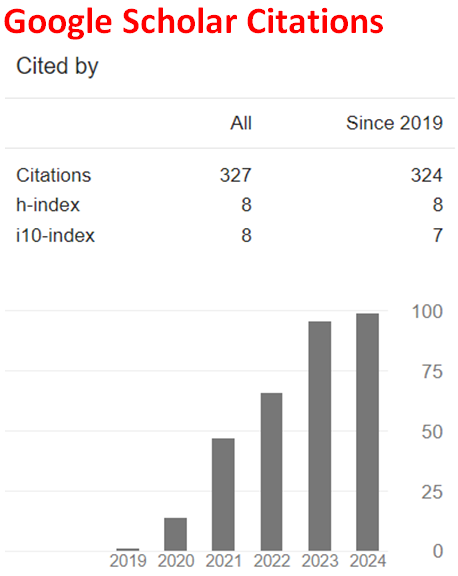Green synthesis of zinc oxide nanoparticles using Lagenaira breviflora aqueous fruit extract and its antimicrobial activity
Abstract
Green synthesis involves eco-friendly approaches to producing materials, including nanoparticles. It is gaining more interest due to its affordability and renewability. In this study ZnONPs was synthesized using aqueous extract of Lagenaria breviflora fruit and assessed for it antimicrobial activities. The Aqueous extract of Lagenaria breviflora fruit was obtained by simple solvent extraction with double distilled water and the extract obtained was used as reductant in the synthesis of ZnONPs via a one pot facial synthetic pathway. The synthesized ZnONPs were characterized using UV-VIS, FTIR, XRD and SEM. The ZnONPs were further screened for their Antimicrobial activities against Escherichia coli, Salmonella typhi, Staphylococcus aureus, Candida albicans and Aspergillus niger using the well-diffusion method. Phytochemical screen carried out on the aqueous extract showed the presence of alkaloids, tannnis, flavonoids, terpenoids, saponins and carotenoids. A UV-vis peak of 357nm was observed for the ZnONPs, FTIR results showed the presence of -OH, -NH, -CH, -C=O, -C=C and -CO functional groups. XRD data confirmed the particles to be crystalline, with average crystallite size of 17.33 nm and the SEM result showed that the crystalline particles are spherical with an average particle size of 82.10nm. The antimicrobial screening of the synthesized ZnONPs showed average inhibition zones of 11mm, 11mm, 12mm, 10mm and 9mm for Escherichia coli, Salmonella typhi, Staphylococcus aureus, Candida albicans and Aspergillus niger respectively. The synthesized ZnONPs showed better activity toward tested micro-organisms compared to the crude aqueous extract. ZnONPs as observed in comparison with the controls Ciprofloxacin and fluconazole can served as potential substitute.
References
Fatehbasharzad, P., Sillanpää, M., & Shamsi, Z. (2021). Investigation of bioimpacts of metallic and metallic oxide nanostructured materials: Size, shape, chemical composition, and surface functionality: A review. Particle & Particle Systems Characterization, 38(10), 2100112. https://doi.org/10.1002/ppsc.202100112
Villagrán, Z., Anaya-Esparza, L. M., Velázquez-Carriles, C. A., Silva-Jara, J. M., Ruvalcaba-Gómez, J. M., Aurora-Vigo, E. F., & Martínez-Esquivias, F. (2024). Plant-based extracts as reducing, capping, and stabilizing agents for the green synthesis of inorganic nanoparticles. Resources, 13(6), 70. https://doi.org/10.3390/resources13060070
Jiang, Z., Han, X., Zhao, C., Wang, S., & Tang, X. (2022). Recent advances in biological responsive nanomaterials for biosensing and molecular imaging applications. International Journal of Molecular Sciences, 23(3), 1923. https://doi.org/10.3390/ijms23031923
Sharma, P., Hasan, M. R., Mehto, N. K., Bishoyi, A., & Narang, J. (2022). 92 years of zinc oxide: Has been studied by the scientific community since the 1930s—An overview. Sensors International, 3, 100182. https://doi.org/10.1016/j.sintl.2022.100182
Mirzaei, H., & Darroudi, M. (2017). Zinc oxide nanoparticles: Biological synthesis and biomedical applications. Ceramics International, 43(1), 907-914. https://doi.org/10.1016/j.ceramint.2016.10.051
El-Saadony, M. T., Fang, G., Yan, S., Alkafaas, S. S., El Nasharty, M. A., Khedr, S. A., & AbuQamar, S. F. (2024). Green synthesis of zinc oxide nanoparticles: Preparation, characterization, and biomedical applications—A review. International Journal of Nanomedicine, 12889-12937. https://doi.org/10.2147/IJN.S487188
Paris, J. L., Baeza, A., & Vallet-Regí, M. (2019). Overcoming the stability, toxicity, and biodegradation challenges of tumor stimuli-responsive inorganic nanoparticles for delivery of cancer therapeutics. Expert Opinion on Drug Delivery, 16(10), 1095-1112. https://doi.org/10.1080/17425247.2019.1662786
Rai, R. S., Bajpai, V., Khan, M. I., Elboughdiri, N., Shanableh, A., & Luque, R. (2023). An eco-friendly approach on green synthesis, bio-engineering applications, and future outlook of ZnO nanomaterial: A critical review. Environmental Research, 221, 114807. https://doi.org/10.1016/j.envres.2022.114807
Wang, Z., Wang, S., Ma, T., Liang, Y., Huo, Z., & Yang, F. (2023). Synthesis of zinc oxide nanoparticles and their applications in enhancing plant stress resistance: A review. Agronomy, 13(12), 3060. https://doi.org/10.3390/agronomy13123060
Sandhu, A., & Goel, A. (2023). Biosynthesis of nanoparticles by micro-organisms and its applications. Journal of Young Pharmacists, 15(3), 430-440. https://doi.org/10.5530/jyp.2023.15.58
Mercuri, A. M. (2022). Plant use. Oxford Research Encyclopedia of Anthropology. https://doi.org/10.1093/acrefore/9780190854584.013.50
Okunlola, B. O., Azeez, S. O., & Faluyi, J. O. (2022). Reproductive biology of two Lagenaria (Cucurbitaceae) species. Botanica Lithuanica, 28(2). https://doi.org/10.35513/Botlit.2022.2.5
Ijeomah, A. O., Tongu, S., & Mtom, J. (2019). Phytochemical screening of Annona senegalenses stem bark and its antidiarrheal effect. International Journal of Science and Technology, 7(7). https://doi.org/10.24940/theijst/2019/v7/i7/ST1907-030
Naseer, M., Aslam, U., Khalid, B., & Chen, B. (2020). Green route to synthesize zinc oxide nanoparticles using leaf extracts of Cassia fistula and Melia azedarach and their antimicrobial potential. Scientific Reports, 10(1), 9055. https://doi.org/10.1038/s41598-020-65949-3
Ahmadi-Shadnehri, A., & Nambar, F. (2020). A review on green synthesis, cytotoxicity mechanism, and antibacterial activity of ZnO nanoparticles. Journal of Research in Applied and Basic Medical Sciences, 6(1), 23-31.
Kannolli, A., Avinash, P., Manohara, S. R., Taj, M., & Kotresh, M. G. (2023). In-depth study of zinc nanoferrite particles at different calcination temperatures and their behavior in the presence of electric and magnetic fields. Journal of Magnetism and Magnetic Materials, 584, 171079. https://doi.org/10.1016/j.jmmm.2023.171079

This work is licensed under a Creative Commons Attribution 4.0 International License.


